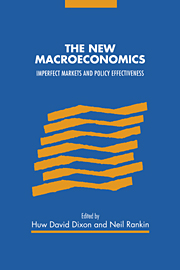Book contents
- Frontmatter
- Contents
- List of contributors
- Preface
- Acknowledgements
- Introduction
- Part I Overviews and perspectives
- 1 Classical and Keynesian features in macroeconomic models with imperfect competition
- 2 Imperfect competition and macroeconomics: a survey
- 3 Notes on imperfect competition and New Keynesian economics
- Part II Goods market imperfections
- Part III Labour market imperfections
- Part IV Financial market imperfections
- Part V Nominal rigidities and bounded rationality
- Bibliography
- Index of authors
- Index of subjects
3 - Notes on imperfect competition and New Keynesian economics
Published online by Cambridge University Press: 13 October 2009
- Frontmatter
- Contents
- List of contributors
- Preface
- Acknowledgements
- Introduction
- Part I Overviews and perspectives
- 1 Classical and Keynesian features in macroeconomic models with imperfect competition
- 2 Imperfect competition and macroeconomics: a survey
- 3 Notes on imperfect competition and New Keynesian economics
- Part II Goods market imperfections
- Part III Labour market imperfections
- Part IV Financial market imperfections
- Part V Nominal rigidities and bounded rationality
- Bibliography
- Index of authors
- Index of subjects
Summary
Introduction
New Keynesian economics is a counter-revolution against the ascendancy of the ‘rational expectations’ and ‘new classical’ schools which dominated macroeconomic research through much of the late 1970s and the 1980s. The New Keynesian approach uses the standard tools of microtheory; that is New Keynesians model consumers, workers, and firms as rational, maximizing agents. Further, markets clear. Thus, the ‘modelling techniques’ of the New Keynesians have much in common with those of the new classical school. The output of New Keynesian models, in contrast, follows along traditional Keynesian lines. Three broad, interrelated results emerge. First, the aggregate economy has multipliers, so an initial shock in the supply or demand for goods will be magnified in general equilibrium. Second, economic fluctuations are frequently not Pareto optimal. Recessions involve real welfare losses that, in principle, are avoidable. Third, government policy can be effective in manipulating output and can be welfare improving in so doing.
New Keynesian models invariably involve market failure, almost always some form of imperfect competition, and usually monopolistic competition. Why the link between New Keynesian models and imperfect competition? To illustrate the problem with the assumption of perfect competition, consider the following question for a hypothetical graduate school qualifying exam.
In this economy, consumers maximize utility and firms maximize profits. Markets are complete and perfectly competitive for all products and across all time periods. Assume any regularity conditions necessary to ensure an Arrow–Debreu equilibrium.
Specifically, the endowments, tastes, and technologies of the economy are as described in the following 666 equations. […]
- Type
- Chapter
- Information
- The New MacroeconomicsImperfect Markets and Policy Effectiveness, pp. 63 - 78Publisher: Cambridge University PressPrint publication year: 1995
- 2
- Cited by



